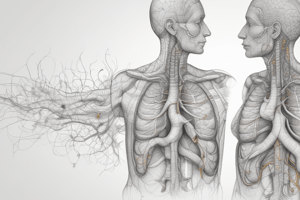Podcast
Questions and Answers
What is the characteristic of Cheyne-Stokes breathing that distinguishes it from normal breathing?
What is the characteristic of Cheyne-Stokes breathing that distinguishes it from normal breathing?
- Long, regular periods of apnea
- Regular cycles of breaths with consistent depth
- Irregular cycles of breaths with increasing depth
- Cycles of breaths that begin shallowly, increase in depth, and reach a peak before diminishing (correct)
Which of the following conditions is most likely to cause Cheyne-Stokes breathing?
Which of the following conditions is most likely to cause Cheyne-Stokes breathing?
- Increased intracranial pressure
- Traumatic brain injury
- Carbon monoxide poisoning
- Congestive heart failure (correct)
What is the primary difference between Cheyne-Stokes breathing and Biot's breathing?
What is the primary difference between Cheyne-Stokes breathing and Biot's breathing?
- Length of apnea periods
- Consistency of inspired volumes (correct)
- Frequency of breaths
- Depth of inspirations
In which situation is Cheyne-Stokes breathing considered a normal finding?
In which situation is Cheyne-Stokes breathing considered a normal finding?
What is the term used to describe the abnormal gait associated with Biot's breathing?
What is the term used to describe the abnormal gait associated with Biot's breathing?
Which of the following is a common cause of Biot's breathing?
Which of the following is a common cause of Biot's breathing?
What is the prognosis of a patient with Biot's breathing?
What is the prognosis of a patient with Biot's breathing?
What is the term used to describe Cheyne-Stokes breathing?
What is the term used to describe Cheyne-Stokes breathing?
What is the primary cause of abnormal hyperpnea?
What is the primary cause of abnormal hyperpnea?
What is the term used to describe the breathing pattern characterized by deep inspiratory gasps held for some seconds before expiration?
What is the term used to describe the breathing pattern characterized by deep inspiratory gasps held for some seconds before expiration?
What is the usual cause of agonal breathing?
What is the usual cause of agonal breathing?
What is the function of the apneustic center in the pons of the medulla?
What is the function of the apneustic center in the pons of the medulla?
What is the characteristic of agonal breathing that differs from Biot's breathing?
What is the characteristic of agonal breathing that differs from Biot's breathing?
What is the term used to describe the Greek word for contest, as in a wrestling match, in the context of medicine?
What is the term used to describe the Greek word for contest, as in a wrestling match, in the context of medicine?
What is the usual outcome of agonal breathing?
What is the usual outcome of agonal breathing?
What is the term used to describe the breathing pattern characterized by very slow, very shallow inspirations followed by long irregular periods of apnea?
What is the term used to describe the breathing pattern characterized by very slow, very shallow inspirations followed by long irregular periods of apnea?
What is the term used to describe the breathing pattern seen in diabetic ketoacidosis?
What is the term used to describe the breathing pattern seen in diabetic ketoacidosis?
Flashcards are hidden until you start studying




